Mapping Paths With Montblanc’s 2019 Novelties
A trip into Vietnam’s caves reminds us of the perils and privileges of watchmaking and the roads not taken.

Montblanc 1858 Automatic Chronograph Limited Edition and Montblanc 1858 Automatic Limited Edition, both in bronze
In our editorial discussions, the subject of our current cover caused considerable consternation. To be clear, no one disputes the virtues of the Montblanc 1858 Geosphere, in any material; the Luxuo editor even rocks one on his wrist quite frequently. No the difficulty emerges in what we have to say about the Geosphere, since we have been covering it in one form or another since 2015. It first appeared as part of the very impressively named Montblanc Collection Villeret
Tourbillon Cylindrique Geospheres Vasco da Gama. What happened was that the Geospheres part of this complication found a new lease of life in 2018 in a much more accessible line, with an easier to manage name. Happily, it then exploded in popularity.
One consequence of that success was a consistent desire on our part to feature the watch. Every time the conversation rolls around to what Montblanc watches deserve our attention, the Geosphere inevitably comes to mind. What we have never done though is put the watch on our cover – we do not recall any magazine that has, since 2018. When we looked at it that way, it seemed we had to act.
To be fair, this particular issue was not a likely candidate, given that we have already gone in-depth on bronze watches in issue #53, going so far as to put a time-only bronze watch on the cover then. That means we will not be getting into the material heart of the 1858 Geosphere in bronze – it was indeed a part of the aforementioned story on the contemporary bronze watch.

Montblanc 1858 Geosphere Limited Edition in bronze
Having said all that, we did have an amazing image of the 1858 Geosphere in bronze, shot earlier this year, and we simply had to use it while it had currency. The issue you are looking at, #55 which is technically our Festive issue for 2019, has the good fortune then to be blessed by a cover shot by the always-amazing Ching. We are deeply grateful to have such accomplished and reliable collaborators around us, and we get more into this in our segment on the cover watch itself, right upfront in the book.
Getting back to the issue at hand, #55 is actually our deep dive into the madness that grips watch lovers and watch brands at the present moment – the steel sports watch. In that regard, the 1858 Geosphere presents an alternative vision and future for the contemporary sports watch. For a touch of that angle, we turn to the editor who happens to own the Geosphere (not this bronze version), who continued his adventure with Montblanc after attempting to summit Mont Blanc itself last year.
On Point
Montblanc has two watch manufactures, the main facility in Le Locle and a more specialised atelier in the old Minerva facility in Villeret. Best-known for its writing instruments, increasingly for its leather goods and more recently (perhaps most ambitiously) for its watchmaking, Montblanc still endures some scepticism in the latter genre.
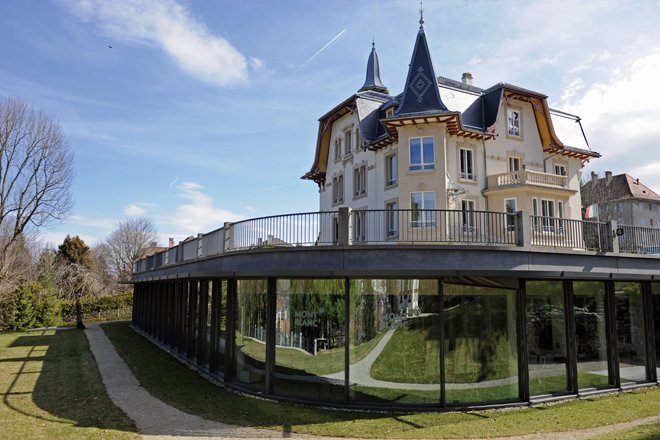
Le Locle Manufacture
That said, neither watchmaking nor mountain climbing (explored by this writer in #50) has ever followed a particularly linear path – there is a start and an end but there are many forks and branches. In short, there are plenty of roads not taken, allegorically speaking, so the journey is what matters, not the destination.
The firm’s Le Locle factory has been producing fine timepieces at relatively large, quality-controlled scale since 1997, but that is not the whole story. Montblanc’s nascent watchmaking ambitions can be traced back to the noughts, when they incorporated the Institut Minerva de Recherche en Haute Horlogerie in 2007.
For the past 12 years, Montblanc has been keeping the legacy of Minerva’s incredible heritage alive in the Villeret manufacture, finding inspiration in a vast cornucopia of design codes and historical references. Had Montblanc not intervened, we would not today be enjoying 160 years of uninterrupted production of exceptional and traditional mechanical objets d’art.

Villeret Manufacture
Founded in 1858 by Charles and Hyppolite Robert, the manufacture has itself ebbed and flowed with the economic realities of each era. Beginning as H & C Robert, to Robert Freres Villeret, the company began registering brand names, usually named for a milestone movement.
This began with “Mercure” and then later moved on to “Minerva”, so-named for the goddess of craftsmanship and growth in 1887. Though each collection had its own name, a common leitmotif was shared – a barbed arrow, a symbol whose significance would be apparent as our trek through the caverns of time unfolded.
Going Under
The area of Tú Làn and the cave network that lies beneath and within the mountainous region, is 70km away from Phong Nha – Ke Bang National Park; even the journey to these caves is an adventure, crossing untouched jungles and fields dominated by buffalo. Surrounded by looming limestone mountains, the 10 caves were discovered within the last 10 years.
Stalactites and stalagmites characterise the maw of the Tú Làn system, specifically the Song Oxalis Cave. This is the oldest of the 10 caves, and it took tens of millions of years to cultivate some of the most bizarre, UNESCO-protected limestone and granite formations. Our guides take us through a leisurely if perilous swim through the dark waters of the labyrinthine caverns. Advised to caution – an errant underwater stroke could send a limb into hidden jagged rocks and there is wildlife to consider – our intrepid adventure recalls the careful navigation and adroit manoeuvres typical of a firm which has survived the better part of two centuries.
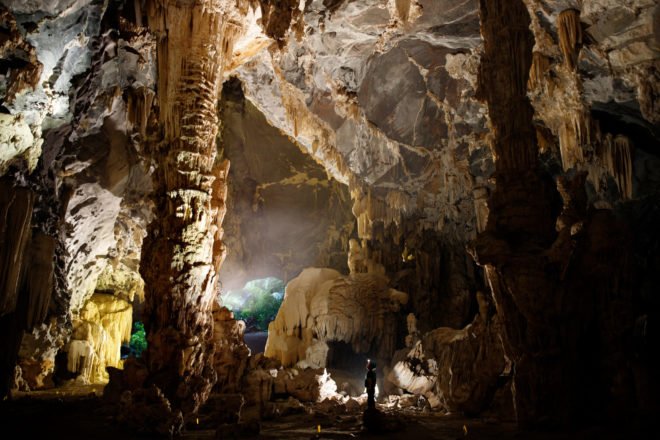
Initially an “etablisseur” of pocket watches using third-party movements, Robert Frères Villeret only began making its own watch movements in 1895, a vital step on its journey to becoming our beloved manufacture. Calling the Bernese, Jura, home since 1902, it would start forging its reputation in chronographs from 1908, eventually debuting the name “Minerva” for its series of specialist timing instruments.
Capable of measuring time accurately to 1/100th of a second in 1916, its mechanical stopwatches were part of a new breed of “professional watches”, fundamental to the evolution of modern-day motor racing. A column-wheel chronograph with a Breguet balance spring, the Minerva Calibre 13-20 was designed as a monopusher but was available after 1940 in double-pusher configurations with 30- or 45-minute counters. Given the success of these calibres, the whole company was renamed “Minerva SA, Villeret” in 1929, right at the start of what historians call,’The Great Depression”.
Navigating Arduous Paths
By 1934, veteran employees Jacques Pelot, a watch engineer, and Charles Haussener, a mechanical technician, became new owners of Minerva when the Robert family suffered financially as a result of the economic crisis. Leaning into their reputation for specialist chronographs, the pair got the company appointed as official timekeepers of the Olympic ski events at Garmisch-Partenkirchen in 1936. With commercial success and international awareness, they parlayed this newfound influence and popularity with the introduction of several new movements, among them, the Pythagore. This movement sported novel architecture thanks to mathematically positioned bridges defined by principles of the Golden Ratio. Though calibres of this era were typically unseen, these aesthetic principles would form the foundation of movement design at Minerva throughout the 20th century.
Armed (no pun intended) with the vintage-inspired 1858 Automatic Chronograph at one of the many forked paths we would encounter within the dank caverns of Tú Làn, we are reminded of the costs and rewards of each and every decision taken. It is worth remembering that Minerva faced the threat of being consigned to the history books more than once, but it succeeded in making the right decisions at crucial moments. One might argue that there are no “wrong” decisions, simply those with greater risk-to-reward ratios.
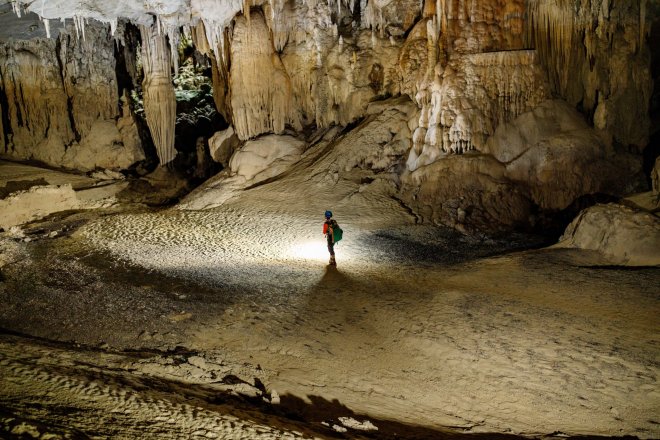
Appropriately priced, the 1858 Automatic chronographs are representative of the Montblanc’s “something for everyone” strategy. It bears the aesthetic hallmarks of its Minerva predecessors but sports the well-made if serially produced chronograph movements of Le Locle. Twin sub-registers sandwich the classic snow-capped mountaintop flanked by “Mont” and “Blanc”, a famous peak we ourselves failed to summit just over a year ago.
Back on point though, a true blue Minerva chronograph, a Grail watch in many a collector’s wish list, might be out of reach but the 1858 Automatic Chronograph is its descendant. It bears all the pedigree of the Villeret watchmaker and has inherited all the know-how and competence of Minerva. Yes, the Minerva calibre is missing but the case work itself from Le Locle bears details and finishing unexpected of a timepiece at this level. Robust yet exquisite, the 1858 Automatic
Chronograph is itself a reminder of the bygone era of ‘gentlemen explorers’, summiting mountains and traversing jungles in tweed blazers, bow ties and caps.
Executed in 42mm bronze, the mix of brushed and polished surfaces create a distinct and compelling chronograph suitable for urban or literal jungles, complete with domed sapphire reminiscent of old school plexiglass. Though not specially rated for the great outdoors, Le Locle’s zero tolerance, 500 hours quality control process has created a breed of timekeeping instruments in a league of their own.
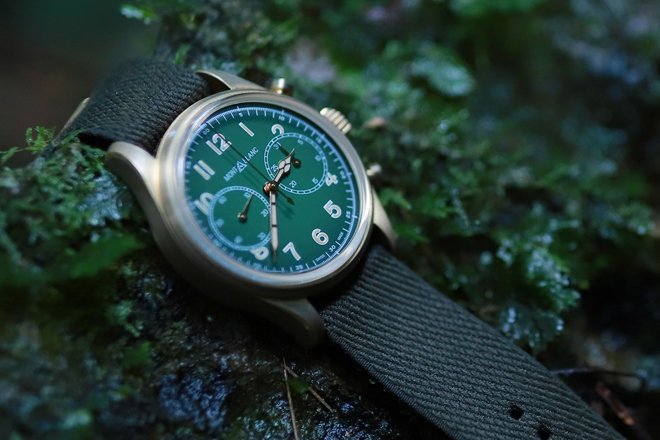
Before the battery of tests are applied to timepieces departing Montblanc’s Le Locle factory, corresponding watchmakers in charge of dials, casing, assembly, each conduct their own specialised checks, pinpointing errors to the micron. While not COSC-certified, Montblanc does offer comparable standards of precision timekeeping through its own in-house regulation and chronometric tests beyond industry benchmarks. Davide Cerato, Head of Watchmaking at Montblanc is keen to explain that the industry basically tests the movements, but people wear the watch, not the movement. Hence the 500 hours of quality control tests the watch in its entirety because missteps in fitting the dial, hands or even during casing might adversely effect the finished timepiece.
Visual controls and rating controls are conducted in all positions; the overall running of the movements with functions activated and deactivated are also examined, along with the absolutely essentially water resistance tests. Hence, here in the water of the caves, and taking glancing blows off rock formations, the 1858 Automatic Chronograph continues ticking even if it was not designed to be an “outdoors” watch. Case in point: the rapid acceleration and impact stop of applause already generates 5 to 20 Gs of force; a golf swing is about 20 Gs and bouncing your wrist off the handrails on the train, that is at least 100 Gs. A timepiece should be rated for living even if not specifically intended for wilderness adventures.
Yes, the Automatic Chronograph without the exhibition caseback revealing the iconic bridges and that distinctive “devil’s tail” or arrow motif feels like a comprise. Given the price point and the financial and horological irresponsibility of taking a work of art like the 1858 Chronograph Tachymeter Limited Edition into the untamed wilds of East Asia, the 1858 Automatic Chronograph seems a prudent choice.
Incidentally, the 1858 Chronograph Tachymeter has another connection to the 1858 Chronograph in this story – it was Montblanc’s first watch with a bronze case, and is thus the direct ancestor of all the firm’s bronze watches.
Out on a limb
Our trek through peaks and troughs off the Tú Làn cave network, along with the accompanying skinned elbows and knees as we indulged in a little rock climbing, was a necessary reminder that even equipped with the knowledge and the resources, there will always be challenges.
The Montblanc 1858 Geosphere is emblematic of peak performance. Yes, Montblanc is home to two distinct collections, the handcrafted objets in small production runs delivered from the hearts, minds and hands of Villeret and the serially produced, competently finished timepieces out of Le Locle. Where the 42mm Geosphere sits is a nice bridge between the two worlds – “A fine watchmaking calibre with a lot of character but at a more accessible price point,” to paraphrase Montblanc CEO Nicolas Baretzki.
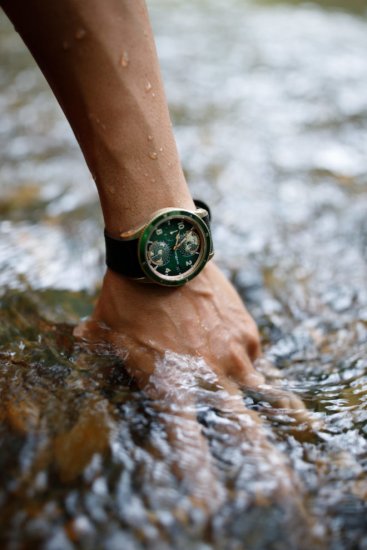
As mentioned in the introduction, few remember this but four years ago, the Geospheres’ complication appeared in the Vasco da Gama, otherwise known as the Villeret Tourbillon Cylindrique Geospheres. For the 1858 variant, what Montblanc has achieved is every bit as groundbreaking in pushing the boundaries of new frontiers, just as explorers Jacques Balmat and Michel Gabriel Paccard did. Their statues can be found in Chamonix complete with tweed blazers and bow-ties because these are the men who completed the first recorded ascent of Mont Blanc.
Indeed, dedicated to the Seven Summits Challenge, the holy grail of climbers with a club counting less than 500, the dream to reach the highest peaks on each continent is allegorical of Montblanc’s ambitions and its objectives of relevance. The Geospheres is a Villeret complication – two domed globes completing a rotation in 24 hours (in opposite directions – as it would if the Earth was two hemispheres instead of a full sphere) with the accessible pricing of a timepiece from Le Locle.
Furthermore, it is a new take on the world timer – a companion displaying every time zone in the world simultaneously. There was a moment during the Tú Làn trek when I almost took the wrong path and stared down at a crevice with deadly jagged rocks below before the guide yanked my belay, holding me back. Companions are important, even if only as reminders of where you are exactly within Tú Làn, and the consequences of bad decisions.
Furthermore, it is a new take on the world timer – a companion displaying every time zone in the world simultaneously. There was a moment during the Tú Làn trek when I almost took the wrong path and stared down at a crevice with deadly jagged rocks below before the guide yanked my belay, holding me back. Companions are important, even if only as reminders of where you are exactly within Tú Làn, and the consequences of bad decisions.
Where Atlas (of old Greek mythology) held the world aloft on his back, we had a world on our wrist. So how does one decide if an in-house world time complication, once offered only by Minerva, would be suitable in a timepiece produced by Le Locle? Would it negatively impact the mentality or market positioning of Montblanc’s premium line or lift the fortunes of its luxurious albeit wallet-friendly collections? Decision-making does not occur in a vacuum nor does it take the form of a binary ‘yes/no’ but in a contextual environment with lots of nuance. In the darkest heart of Vietnam, the remarkable combination of modern black ceramic bezel coupled with vintage hands and classic 1900s Montblanc logo, beige lume and the textured globes, the Geospheres manages to look equally good on a hike and as it did at the airport lounge.
According to Alexander Schmidt, Business Director, Institut Minerva de Recherche en Haute Horlogerie, Montblanc had the opportunity to work with Minerva not through some twist of fate or luck of the draw. Instead, it was an educated decision based on a panel of presentations from most of the Richemont brands, of which Montblanc presented the most potential.
Here in the depths of Tú Làn, we find that exploration follows a similar process: educated guesses based on experience and instinct. On this occasion, it is the dedication to the paths eventually taken and the determination to see it to successful completion. A journey of 2 days and 12 hours later, we emerged into the daylight of Montblanc’s bright future.
Writing in time
Montblanc offers two thrilling versions of the world’s favourite timekeeping complication.
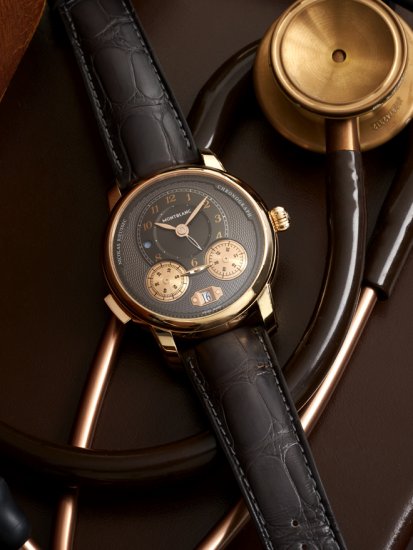
In the main section of this story, the star of the piece was the 1858 Automatic Chronograph. As noted, this is just one of a number of great Montblanc chronographs. There are bi-compax and tri-compax tickers, and even one without traditional subsidiary dials. There are also monopushers and standard twin pushers – but certainly more than one version of both. Indeed this might make Montblanc the only manufacture to have both breadth and depth in this area. While we gave the 1858 Automatic Chronograph its due, we would be remiss to not spare a few paragraphs for the 1858 Split Seconds Chronograph and the Star Legacy Nicolas Rieussec Chronograph.
These two models in particular explain the Montblanc chronograph proposition, both offering insights into the Villeret and Le Locle mindsets.
1858 Split Seconds Chronograph
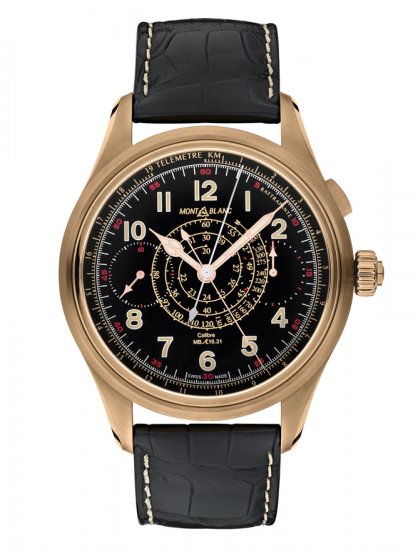
Such a handsome watch hardly needs any words of praise – pictures will do. This is a very special chronograph though, bearing all the aforementioned hallmarks of the Villeret manufacture. That is reason enough to wax lyrical about this split seconds chronograph – a rare function from Montblanc, and relatively uncommon in watchmaking overall. Uniquely in recent years, this split seconds chronograph is a monopusher, which does require a bit of an explanation. You will have noticed that the pusher at 2 o’clock appears to be accompanied by another crown-mounted pusher, and you would be correct. The pusher on the crown controls all the functions of the chronograph (start, stop, reset) while the other pusher controls the split function. Apart from being an unusual configuration, the arrangement of the pushers aligns the watch closely with the other chronograph variants in the range, especially those with in-house calibres.
Another key connection between the 1858 Split Seconds Chronograph and a number of important chronograph references from Montblanc is the use of bronze. This material has defined various connections between the Villeret and Le Locle lines, and was first deployed in the 1858 Chronograph Tachymeter in 2016. The other important connection there is the calibre MB M16.31 that powers the watch, which sports all the excellent finishing of the Villeret manufacture, plus no less than three column wheels. It basically an evolution of the calibre MB M16.29 that powered the 1858 Chronograph Tachymeter. Clearly, Montblanc is being both methodical and deliberate in establishing the genealogy of these chronograph models.
Star Legacy Nicolas Rieussec Chronograph
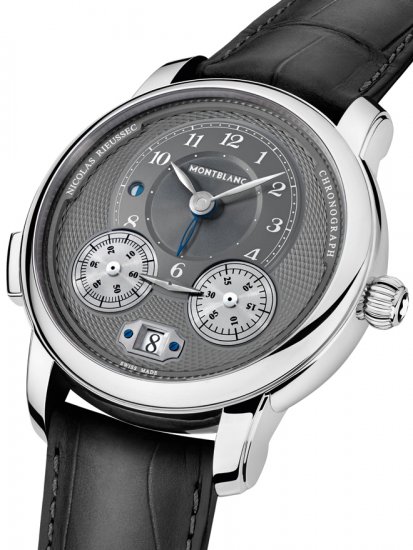
Montblanc first paid homage to the inventor of the device measuring brief intervals of time by dedicating its innovative Montblanc Nicolas Rieussec Chronograph to the ingenious watchmaker in 2008. It so happens that this Le Locle-developed chronograph was a monopusher from the start. Like the original chronograph from 1821, the chronograph hands do not rotate above the dials. Instead, they remain motionless while the seconds disc and minutes disc turn underneath them. The Star Legacy Nicolas Rieussec continues the heritage of the signature 60-second and 30-minute counters, below a fixed double index much like the original desktop apparatus. The mechanical chronograph with the automatic winding system of Calibre MB R200 now features a new going train with special toothing for more efficient power transmission. There is minimal disruption to the balance’s amplitude whether the chronograph is running or not.
Montblanc has taken great pains to ensure utmost practicality, showcasing rapid reset of the hour hand and quick set date display either forwards or backwards, contrary to most modern timepieces where the date should only be set forward to avoid damaging the mechanism. Hence it is designed for global travellers with its robust ease of time and date adjustment, maintaining a connection to the broad travel theme that undercuts Montblanc’s timepiece collections. This is important when you consider that the Nicolas Rieussec chronograph marked a pivotal milestone for Montblanc, as far as its watchmaking pedigree goes.







